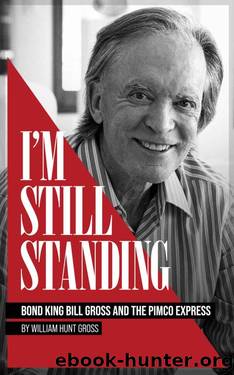Iâm Still Standing: Bond King Bill Gross and the PIMCO Express by William Gross

Author:William Gross [Gross, William]
Language: eng
Format: epub
Publisher: William Hunt Gross
Published: 2022-03-02T05:00:00+00:00
Itâs true that interest on debt is a legitimate expense and a valid part of the deficit, but the fact is that most of it is plowed right back in to the purchase of U.S. Treasuries. Sure, mom-and-pop on Main Street may need their interest to pay the bills in retirement, but most holders of debt such as foreign governments, pension funds, and other institutional type accounts are in a cash flow surplus situation and simply reinvest their coupons into the market. That means the $200 billion dollars in interest payments this fiscal year are basically not a part of the deficit when viewed from a supply/demand standpoint. Instead of a deficit of $70 billion, the U.S. is running a primary surplus of $130 billion.
Think what that implies. It suggest that the Treasury is issuing debt much like U.S. corporations issue stock, and that the âunder the tableâ its holders are using the âprofitsâ or the interest to buy back all of it and then some, just like corporations are doing in todayâs equity market via stock buy-back programs. While the deficit is still increasing, itâs obvious that itâs not expanding enough to meet the needs of its existing holders. There appears to be a shortage of Treasuries, much like Salvigsen foresaw back in the 1980s.
This shortage is most immediately apparent in the Treasury Bill market, where the net issuance of Treasury Bills is actually shrinking. Since foreign central banks and other conservative buyers purchase Bills almost exclusively, and because their purchases have been increasing dramatically over the past several years, the yield on 3- and 6-month paper is trading well below the yield on overnight Fed Funds established by the Federal Reserve at 5½%. As a matter of fact, 3-month Bills at 4.95% are barely yielding more than a passbook savings account at your local bank. That low of a yield for active managers such as PIMCO, with a positive outlook on the market and a Butler Creek style of investing, signals just one thing â extending maturities to pick up more yield. And that is why two-year Treasuries now yield 6% without an immediate prospect for lower Fed Funds and why 30-year bonds yield 6.7% under the same circumstances. In addition, the longer parts of the yield curve have their own reduced supply to contend with. The Treasury, for instance, has just canceled a quarterly issuance of ten-year notes that the market had adjusted to with higher yields. Now, the situation is reversed. The supply squeeze is on, and as long as the economy continues to slow and inflation remains benign, weâll witness a better tone to bond market over time.
The bond marketâs prospects, while excellent, come nowhere close to the recent results sprouting out of the equity turf inhabited by my namesake Peter Lynch. But thatâs a story for another Outlook and perhaps another book. If weâre to get those 8% equity returns over the next several years that my book suggests, then the stock market had better slow down real soon or Iâm going to have to re-title my existing one.
Download
This site does not store any files on its server. We only index and link to content provided by other sites. Please contact the content providers to delete copyright contents if any and email us, we'll remove relevant links or contents immediately.
Hit Refresh by Satya Nadella(9041)
The Compound Effect by Darren Hardy(8818)
Change Your Questions, Change Your Life by Marilee Adams(7639)
Nudge - Improving Decisions about Health, Wealth, and Happiness by Thaler Sunstein(7622)
The Black Swan by Nassim Nicholas Taleb(7016)
Deep Work by Cal Newport(6888)
Daring Greatly by Brene Brown(6451)
Rich Dad Poor Dad by Robert T. Kiyosaki(6414)
Principles: Life and Work by Ray Dalio(6226)
Playing to Win_ How Strategy Really Works by A.G. Lafley & Roger L. Martin(5937)
Man-made Catastrophes and Risk Information Concealment by Dmitry Chernov & Didier Sornette(5926)
Digital Minimalism by Cal Newport;(5669)
Big Magic: Creative Living Beyond Fear by Elizabeth Gilbert(5616)
The Myth of the Strong Leader by Archie Brown(5429)
The Slight Edge by Jeff Olson(5353)
Discipline Equals Freedom by Jocko Willink(5291)
The Motivation Myth by Jeff Haden(5158)
Stone's Rules by Roger Stone(5027)
The Laws of Human Nature by Robert Greene(5003)
